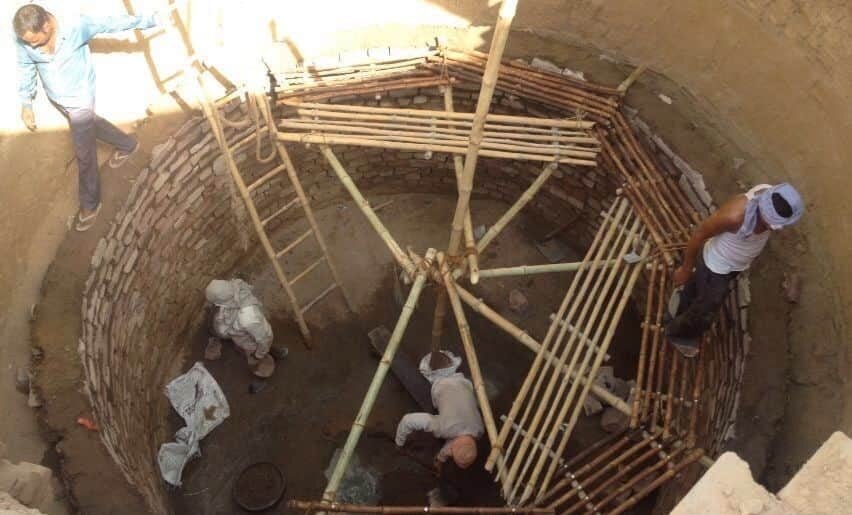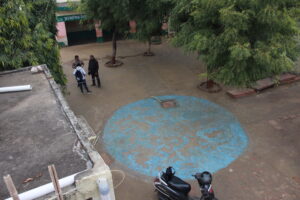Centre for Urban and Regional Excellence
The city of Agra is running out of groundwater. As the main river, Yamuna, is contaminated and untreatable, people’s access to clean water is limited and impoverished people have been disproportionately affected. The scarcity of clean water causes health problems, hinders formal education and productivity, and perpetuates poverty. Women are burdened with the task of collecting and storing water from public sources, and frequent illness caused by unclean water, such as diarrhoea, strains family finances and well-being.
CURE works on rainwater harvesting to improve the water resilience of urban impoverished communities, with projects of community-led rainwater harvesting that aim to build socially coherent, water resilient neighbourhoods. Communities are mobilised and organised to share their knowledge and skills to design and implement leakage and wastewater treatment systems, and become active participants in developing rainwater collection systems for their communities, from choosing the location to installation and operation. The diversity of sites and social groups has helped achieve two goals in particular:
- To establish a more engaged and deeper social process and a stronger community structure.
- To construct and verify the concept of resilience, advancing its replicability and scalability.
These rainwater harvesting systems have been installed by communities in a variety of environments, such as schools, mosques, community halls and homes. One such system was piloted in the school and residential settlements of Tedi Bagia and Ambedkar Bagichi in Agra, Uttar Pradesh, where residents constructed seven large rainwater harvesting tanks using traditional well-making techniques, and the locally available khanda stone, to capture and store rainwater on rooftops. A collaboration between communities and local associations, the education department and the Agra water department, the key objectives of the project were:
- To mobilise lowered-income communities to use traditional knowledge and water wisdom to restore their neighbourhoods’ natural ecology.
- Implement and achieve a critical mass of sustainable household and community interventions for neighbourhood water resilience.
- Identify systemic challenges constraining the implementation of water resilience interventions in low-income neighbourhoods.
CURE used an ecosystem approach to implementation, connecting the dots to create an enabling environment for water resilience, through key activities to fulfil the project objectives.
In Agra, a critical mass of people from lowered-income neighbourhoods came together to create neighbourhood water resilience plans. For an on-site demonstration, the selected communities were contiguous with the seven existing community rainwater harvesting systems. Rapid evaluations, transect walks, street corner meetings, and focus groups were employed to assess the water conditions in the area. People from the community mapped local water resources and their functions, wastewater hotspots and flooding zones, and discussed options for creating water data for their neighbourhoods. An ethnographic and historical understanding of traditional water practices and systems was thus developed using community dialogue. The nature and strength of influence was assessed using a map of significant influencers.
Primary water data on the hydrology, topography, water quality, rainfall and pollution was collected and analysed to understand the kinds of underwater aquifers and their condition, the degree of damage, and to identify technical possibilities. Secondary data including city, state and national guidelines, circulars, mission papers, development controls[1] and other documents relating to sanitation and water[2] were also reviewed.
A sanitation manager position was created for the city to archive, store and employ data for water resilience management and planning. Systems for rainwater and groundwater harvesting, decentralised wastewater treatment and other technical designs, as requested by residents for their communities, were produced with the help of environmental and civil engineers and were tailored to community needs. Communities with the capacity to manage construction were then given financial aid.
For integration and capacity creation, CURE helps cities with the technical designs needed to implement water resilience projects, prepare proposals to spend Smart City money effectively, examine guidelines, and perform other activities to identify gaps, overlaps or contradictions in the area of water, to better align these and suggest ways to resolve them.
RWH System Agra, in Tedi Bagia and Ambedkar Bagichi
The full range of interventions in Agra has directly benefited over 11,000 low-income households (of 60,824 people) in 24 lowered-income settlements that have seen economic, ecological, health and social improvements.
Through a network of pipes and drains, the seven large rainwater harvesting tanks in Ambedkar Bagichi store 5.5 million litres of rainwater each year. The collected water can be used for drinking and cooking, and community members are maintaining and managing the system for the long run. Last year’s scanty rainfall had little impact on the water supply in the school, and the system has been replicated in Delhi, in government schools, a community centre, and five other places, and in cities like Rourkela in Odisha.
Access to good quality drinking water has meant reported monthly savings of 150 INR (2 USD) per household per month on buying poor quality water from private tankers, and of 150 INR per month on medical expenses for gastrointestinal treatments. The city saves an estimated 3.5 crore INR (420,000 USD) annually on energy from reduced groundwater pumping requirements and tanker supplies.
In Delhi, the residents of G-block, Savda Ghevra, a resettlement colony, led the construction of a harvesting system in the Basti Vikas Kendra community development centre, where four connected overground tanks capture 8,000 litres of rainwater, with the overflow routed to a groundwater recharge area. The system is managed by a Residents’ Operation and Management (O&M) committee, whose members are chosen by residents and trained in the O&M process. The system has been further replicated at five other locations in Savda Ghevra.
The next system to be built in Agra will have a harvesting capacity of 160,000 litres of water. As more households and communities start harvesting, the city will also eventually see fewer patients in the public health system. At the school in Tedi Bagia, rainwater harvesting systems are storing enough water for 320 children for 250 school days, or 200,000 litres of water[3], and with the lowered incidence of diarrhoea, school enrolment and attendance are also beginning to improve. Each school saves 15,000 INR (182 USD) monthly on buying water and over 4,000 INR annually on cooking fuel, which now lasts longer, as it no longer depends on groundwater, which in Agra is full of salt and minerals, and takes longer to boil.
The city of Agra has leveraged over 4 380 000 USD to upscale rainwater harvesting and decentralised waste management systems in its Smart City plan. CURE aims to make Agra water resilient in the longer run, and has prepared an elaborate video tutorial for the use of communities and local governments to facilitate their understanding and adoption of rainwater harvesting.
The system has also been replicated in other Indian cities, including Delhi, Gurgaon (Haryana) and Rourkela (Odisha). We are currently working on a water-resilient school and residential settlement in Delhi.
[1] http://cgwb.gov.in/AQM/NAQUIM_REPORT/UP/Agra%20NAQUIM%20Report.pdfhttps://idup.gov.in/en/page/organisation-structure-yamun-okhla
[2] https://www.ijser.org/researchpaper/RAINWATER-HARVESTING-RWH-A-REVIEW.pdf
https://www.resilienceshift.org/wp-content/uploads/2019/04/CWRA_City_Water_Resilience_Approach.pdf
https://cpcb.nic.in/industrial_pollution/New_Action_Plans/CEPI_Action%20Plan_Agra.pdf
https://www.questjournals.org/jmdsr/papers/vol3-issue6/H364450.pdf
https://nagarnigamagra.com/pdfs/City%20Sanitation%20Plan.pdf
[3] For the 528 sq m roof area of the school, with a 0.8 runoff coefficient for concrete and 751 mm average annual rainfall in Agra (District Groundwater brochure, Groundwater Department, Agra), there is potential to collect 317,222 litres of rainwater from the school rooftop. Given the potable water demand is 1,000 litres and over 250,000 litres of water was harvested from two rainspots (one in the monsoon and one before winter), the supply of water will easily meet the demand over 250 days.




















